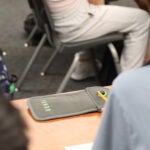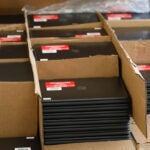Cellphone Policy Catching on with Students, Parents
Summary : Students and staff at Eagle Staff and Hamilton International middle schools are noticing the positive change after pushing for cellphone-free campuses

Away for the Day
The steps have become so engrained in students that they don’t even think about it anymore.
- Put phone in pouch.
- Hold pouch to magnet to engage lock.
- Place pouch in backpack.
- Phone stays away for the day.
Such is the case at Hamilton International and Robert Eagle Staff middle schools, where school leaders, staff, and parents have joined forces to help students stay focused in the classroom. This year, both schools introduced Yondr pouches, which allow students to lock away their phones in a secure bag, limiting their use throughout school hours. Pouches can only be unlocked by school staff or at designated stations at the end of the school day.
While students maintain ownership of their phones, the pouches prevent their use during instructional time, creating an “away for the day” atmosphere that prioritizes learning. The goal is to balance the role of technology while reducing distractions.
Seattle Public Schools (SPS) acknowledges the important role technology plays in classrooms, but in recent years, the district has noticed that personal devices, particularly cellphones, have increasingly contributed to distractions, impacting both students’ focus and their social interactions.
Robert Eagle Staff Principal Zac Stowell felt compelled to participate in the pilot program after previous tactics stopped working, and teachers were spending educational time policing students and their phone usage. Principal Stowell also said students would become even more isolated after their phones were taken away.
“I don’t want to take it for granted that things are going to be fine. [Students] don’t have phones in their hands, and there’s anxiety that’s built up in that,” he said. “I fully understand that this is a way kids connect, but this also must be a safe place with learning for all … so, to isolate kids who are already negatively impacted by cellphones was a reason to shift to these pouches … to give everyone a fair approach to access learning.”
Principal Stowell shared how one student felt liberated by being in a space where cellphones were not allowed. They felt less fear around having unflattering images floating around on social media. He said the school is focusing on “replacement behaviors” by having more activities like board games and music during lunch. They are also engaging in getting students outdoors and into the woods to build relationships, community and connections.
Bryan Getchell is a 7th grade Washington state history teacher at Hamilton. He explained how their school’s cellphone policy is allowing teachers to do just that – teach.
“I think the workday for myself and my colleagues is filled with lots of asks. This is one less ask on us to have to take care of,” Getchell said. “It feels good. Honestly, it feels great.”
Some students are now seeing the benefits of having their phones out of sight. It has cut down on the spread of misinformation and helped curb students from congregating in bathrooms and hallways. For Eagle Staff 8th grader Nuray B., it means more seat time in class.
“I remember in 7th grade, I would go to the bathroom for 15 minutes and just be on my phone, and I would get in trouble for that, but now I don’t do that,” she said.
Hamilton’s Parent Teacher Student Association (PTSA) played a pivotal role in securing the Yondr pouches for their school. Co-president, Molly Branson Thayer, is excited about the pouches and how they have helped lower disciplinary infractions.
“There’s definitely been a dip in incidents,” she said. “If you talk to Dr. [Eric] Marshall, he has not had a phone complaint this year since Yonder pouches. He has not been called to a classroom to remove a phone.”
While some parents have expressed concerns over students not having immediate access to their phones in an emergency, Branson Thayer said their research showed it is best for students to not be on their phone during a crisis.
“We’ve contacted principals all over the country who are using Yonder pouches – principals who have had school emergencies – and what they’ve resoundingly said is you don’t want kids on cellphones during an emergency. You don’t want their phone ringing, you don’t want them talking, you don’t want the light from their phone on. You want them focused on their teachers.”
Hamilton and Eagle Staff will spend the year gathering feedback from students, teachers, and families to assess the impact of Yondr pouches. This feedback will be crucial as SPS evaluates whether this approach should be expanded to other schools or if adjustments need to be made for future cellphone policies.
For now, the pouch pilot serves as an experiment in fostering better student engagement and helping them develop a healthier relationship with their devices during school hours.



